Contents:
- What is the danger of improper storage of products?
- Basic storage rules
- Useful recommendations
- What should be the ware for storage?
- Overview of bulk material materials
- Spice storage features
- Popular secrets for long-term storage
Any hostess should have an idea of how to store products, including non-perishable: rice and other cereals, pasta, flour, sugar, tea and tetc. Temperature regime, humidity level, selected capacity for bulk products - all this matters. After all, it is often improper storage that leads to food spoilage. A spoiled food not only loses its flavor, but also becomes hazardous to health.
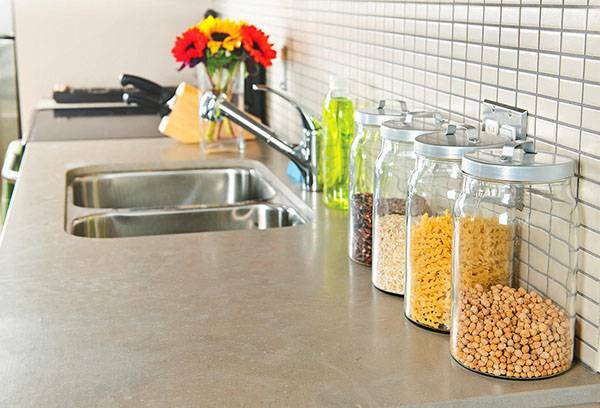
What is the danger of improper storage of products?
One of the enemies of loose products, especially cereals, is the mold, which usually develops due to high humidity in the kitchen. Breeding, it destroys the products, resulting in an unpleasant odor, toxins are formed. Eating food contaminated with mildew is dangerous to health.
In loose products, insects may also appear. One of the most common pests is Surinamese. This is a brown bug, which is planted in flour, different grades of cereals, dried fruits. Unlike microorganisms, insects do not destroy cereals, but contaminate them. But at a high concentration, pests or products of their vital activity can lead to food poisoning.
Overdue products, although visually and look normal, lose their taste and useful properties. Even if you know how to store cereals, it is important to remember that bulk products can not be stored forever. If you prefer to buy for the future, first try to cook from products purchased long ago. And in order not to confuse anything, containers can be pasted onto containers with the date of bookmarking the content.
From cereals, oatmeal flakes are most quickly spoiled - for 4-6 months, and flakes with all kinds of additives are kept even less. Rice can be stored for about 1.5 years, peas and buckwheat groats - up to 2. Other cereals should be consumed within 9-12 months. Simple macaroni lay about 1 year. And macaroni products with various additives, for example tomato, it is recommended to store no longer than 3-5 months.
Council
Annually make an audit in the kitchen, during which check the expiration dates of the contents of the cabinets and, if necessary, throw away all the spoiled.
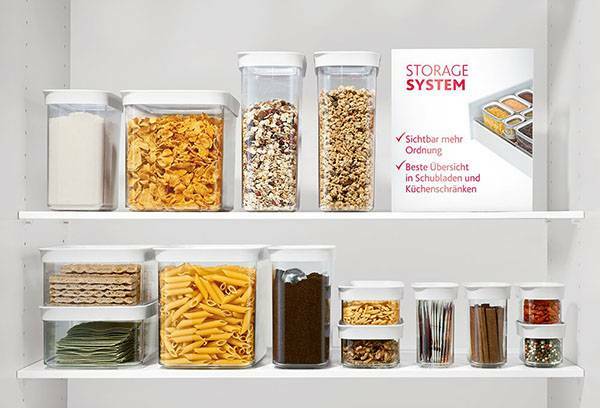
Basic rules of storage
To avoid problems with products in your kitchen, carefully study them in the store. Damaged packaging, stuck grains, foreign inclusions among grains - all this signals that the goods should not be bought. If it is not possible to evaluate the product visually, for example, if it is sold in an opaque package or box, refer to the production date and the recommended shelf life.
Despite the fact that measures are being taken to prevent the infection of cereals by insects, unpleasant exceptions occur. Therefore, before removing the croup for storage, it is recommended that it be checked once again for mold and larvae and poured from the shop container. Some prefer to leave rice and other cereals in plastic bags. But it is not recommended to do this: in them the products can damp, "suffocate" and acquire an unpleasant smell and taste.
It is better to store flour, rice, sugar and other products in closed jars and containers. Before you drop something into the jar for storage, it must be washed well with a cleaning agent and dried. For storing products in large volumes, a canvas bag, prepared in saline solution, is suitable. Matter allows products to "breathe" and do not lie, and the salt barrier does not allow insects to get inside.
Bulk products should not be stored under sunlight. The best place for them is a kitchen cupboard. It's dark, cool and dry - these are the best conditions for bulk products. Sacks with sugar can not be put directly on the floor. They should be placed on a pallet away from sources of moisture and heat.
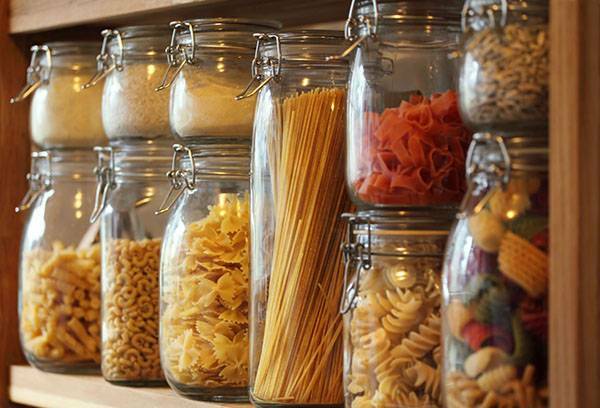
Useful recommendations
- During storage, the humidity of the air in the room should not exceed 65-70%, and the temperature - 19-20 degrees.
- For mango, pearl barley, millet and oatmeal, cool storage is desirable. Otherwise, they can get a bitter taste. This is due to the fact that at a temperature above 16-18 degrees vegetable fat can rancid. If you can not maintain this temperature, buy these cereals in small amounts.
- Storage of cereals in basement, poorly ventilated and damp areas is not allowed.
- Do not collect sugar, flour and spices with a wet or damp spoon. A wet product can not only lose its qualities, but also become moldy. For the same reason, it is not necessary to keep open containers with bulk products over a pan or frying pan when there is something prepared.
- Do not store salt, sugar, flour, rice or other cereals in open containers near products that have a strong odor. Such products include spices, dried mushrooms and herbs.
- Also near the place of storage of bulk products should not stand cleaning and detergents containing odoriferous fragrances.
- To preserve the taste of products and protect them from spoilage, try not to do bulk purchases without special need. It is better to update the inventory as you use.
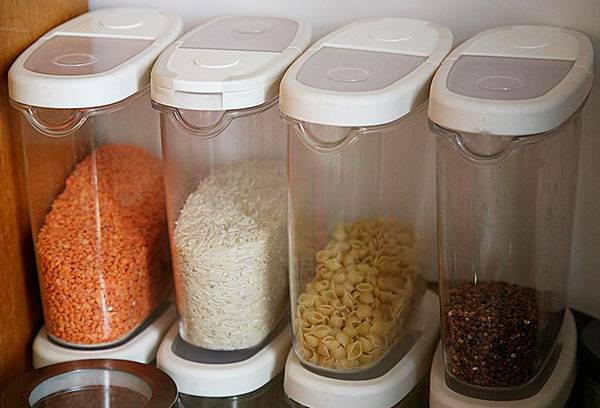
What should be the ware for storage?
Glass, ceramic, plastic and other containers for storing cereals, sugar and tea can be found in stores in large quantities and at different prices. Many housewives choose a set of containers, based on aesthetic preferences, as well as the design features of the kitchen. To keep loose products fresh and taste, in addition to the external appearance, it is worth considering a number of other indicators.
In milling, cereals and legumes, a moth and a beetle can start. Also in the kitchen, where food is constantly prepared, there are extraneous smells. You do not want your tea to get the smell of roasted meat? That's why the dishes should be airtight, and the lid - dense. In addition, the hermetic capacity of products is not afraid of increased humidity. With this task, the lids with seals perfectly handle. A good option - folding lids with snaps, which allow you to store products in both tightly closed and ventilated containers.
If you prefer to store products on open shelves, choose an opaque container that will not pass light. The material from which the dishes are made should not have any foreign smells. For example, containers of poor-quality plastic have a very unpleasant smell, which can go to products. It should be noted that some materials absorb the aromas well. This means that the dishes made of such materials will retain the smell of the contents for a long time. For example, a wooden container after storing coffee in it can smell of this product for several more years.
No less important is the size and shape of the tank. A set of square or rectangular containers, unlike cylindrical ones, will take up less space, which will allow more food in one locker. If you want to use space efficiently, choose containers that are as close to the height of the shelf as possible. If you have a large family, in which the products are consumed very quickly, it is better to give preference to large-size containers. For cereals, which you eat rarely, small dishes will do.
It is worth knowing the
. Many make a serious mistake: they take cereals, for example rice, on top of the container, then fill up a fresh portion, and then again take rice from above. Thus, the croup, located on the bottom, is not used at all. This can lead to spoilage of the product, as well as the appearance of moths and bugs. Do not forget that containers with bulk goods should be completely emptied from time to time.

Overview of materials for bulk solids
- Glass
Glass jars are considered ideal for storing non-perishable products. Through the transparent walls you can clearly see what is stored in them. Glass containers are easy to clean, it does not absorb foreign smells. The main disadvantage is that the glass can easily break. Today, on sale there are dishes made of shock-resistant material, but its cost is higher than usual. Products placed in transparent glass jars can only be stored in a dark place.
- Plastic
The choice of shapes, colors and sizes of plastic containers is quite extensive. They are of low cost, they are light and compact. But plastic containers are not recommended for storing seasonings. Many spices, when interacting with plastic, release toxic substances.
Over time, plastic may crack, deform under the influence of high temperatures, cloud or yellow. Another drawback: some types of plastic have a persistent unpleasant odor. Before buying, be sure to smell the container: a faint smell will eventually fade away, but a container with a sharp chemical smell should not be bought. And pay attention to the lid: not all plastic containers fit tightly.
- Ceramics
Ceramic jars are not only comfortable, but also very beautiful. They are opaque, but you can buy a set in which, by color and pattern, you can easily determine what lies in each bank. Ceramic jars do not have extraneous smells and are easy to clean. Do not take a container, where the lid simply lies on the bank and is not snug against it. It is better to give preference to banks with silicone gaskets.
- Metal
Metal containers are light and durable, but not the most practical. Such cans can give the products a slight metallic taste. In addition, high humidity in the kitchen can cause rust, which is unhealthy. If you still decide to give preference to metal containers, choose quality stainless steel containers that are not susceptible to corrosion.
- Wood
Wooden containers look very colorful and interesting, but to store most of the products are not suitable. They absorb moisture and odors, do not differ in tightness, they are difficult to wash. In addition, usually these vessels are not equipped with sealed caps. Wooden containers are convenient for storing bay leaves, dried herbs and salt.
Advice
When buying ceramic container, do not confuse it with melamine - toxic and harmful to human material. Despite the external resemblance to ceramics, it is easy to distinguish such a dish: at the bottom of the melamine plant there is a sign in the form of the letter "M".
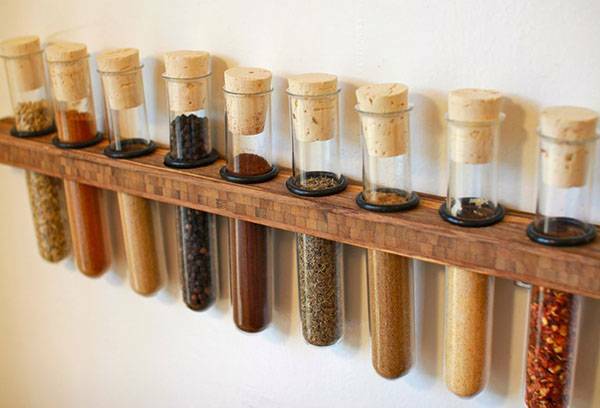
Features of storing spices
There are many natural aromatic additives - spicy herbs, dried inflorescences, roots, etc. Seasonings can not spoil or sour. But if stored incorrectly, they can lose their flavor and flavor. In general, when storing spices, you must follow the same recommendations as when storing all other bulk products. But there are several nuances that must be taken into account.
First of all, it is necessary to take into account the shelf life of spices. Seeds are stored up to 3-4 months, spicy herbs - 1-2 years, ground spices - no more than 1 year. Records of the shelf life among spices are cinnamon, pepper and cloves. Spices in inflorescences or pots should be grinded just before adding to the dish, as they lose their properties faster in the ground form.
Many people buy condiments in sachets, which, after opening, lose their tightness. To preserve the taste and aroma, season it better to pour into small ceramic or glass jars. Do not forget that spices do not like overheating, so they should not be stored next to a gas stove. Seasonings based on red pepper( paprika, chili) should be stored in the refrigerator. For the rest of spices, storage in the refrigerator is not required.
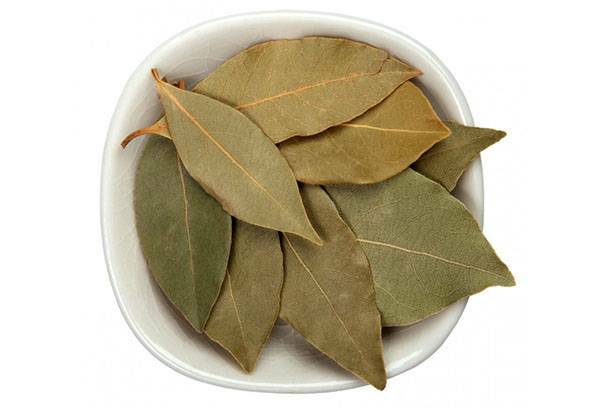
Folk Secrets for Long-Term Storage
- To prevent insects from getting into the croup, put it on 1-3 days in the freezer directly in the package from the manufacturer. You can also burn the rump in a frying pan, in an oven or microwave oven.
- Put the red hot pepper in the rice. Pepper not only protects rice from insects, but also prevents the appearance of musty smell.
- You can put a rag-bag of salt on the bottom of the crock.
- Also in rice, you can put an uncooked garlic slice or a piece of dried lemon zest. Chestnut will also help protect the cereals from the appearance of bugs and worms.
- Put a piece of twisted foil, a metal spoon or a bay leaf into the flour.
- Very often salt is caked with lumps. To avoid this, put rice into it( there will be enough grains).
- Ants can get into the sugar. To prevent their appearance, put in a bag of sugar a few dry orange or lemon crusts.
- To prevent the appearance of bugs during the spring cleaning, wipe the kitchen cabinet with a solution of vinegar. And to get rid of the smell of vinegar, lay on the shelves of wadded disks, soaked in lavender oil.
- To be dry in the kitchen cabinets, lay out laurel leaves or glass cups with lime in the corners. You can also put a few open containers of salt, which absorbs moisture and disinfects.
Observance of all conditions of storage of products not only protects your reserves from spoilage, but also allows maintaining cleanliness and order in the kitchen. If you still miss something, and this led to the appearance of mold or insects, without regret get rid of these products. Do not save on your health.
We recommend reading an article on how to store flour at home



